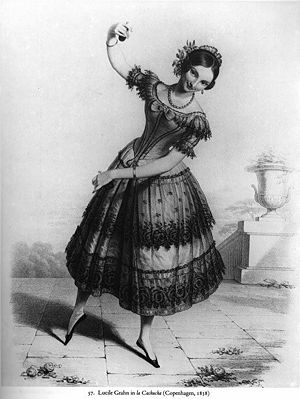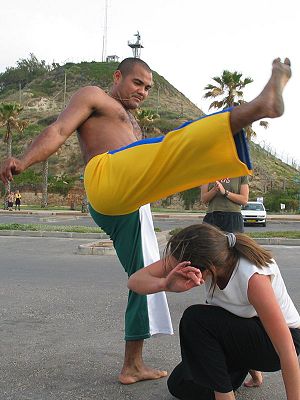Dance: Difference between revisions
imported>Micha van den Berg No edit summary |
imported>Micha van den Berg No edit summary |
||
| Line 22: | Line 22: | ||
There is also a possibility that dance has a purely biological basis, with different kinds of repetitive bodily motions releasing various hormones and therefore changing the brains chemistry, or that dance allows a human to release build up tension in there muscles. | There is also a possibility that dance has a purely biological basis, with different kinds of repetitive bodily motions releasing various hormones and therefore changing the brains chemistry, or that dance allows a human to release build up tension in there muscles. | ||
This article has divided dance into | This article has divided dance into four related categories: | ||
*'''Performance dances''': Where a dancer performs for an audience, in order to entertain, amuse or move the viewer. | *'''Performance dances''': Where a dancer performs for an audience, in order to entertain, amuse or move the viewer. | ||
*'''Social dances''': Where different dancers come together in order express there need for social interaction; using dance as a means of communication, finding a suitable partner or showing people there physical abilities. | *'''Social dances''': Where different dancers come together in order express there need for social interaction; using dance as a means of communication, finding a suitable partner or showing people there physical abilities. | ||
*'''Ritual dances''': | *'''Ritual dances''': | ||
*'''Ethnic dances''': | |||
There are dance forms that cross over into more than one category. Folk dance, for example, a type of social dance, has elements that have become mainstream ballroom. | There are dance forms that cross over into more than one category. Folk dance, for example, a type of social dance, has elements that have become mainstream ballroom. | ||
Ballet is normally considered exhibition dancing but is practiced by millions as a hobby. | Ballet is normally considered exhibition dancing but is practiced by millions as a hobby. | ||
==Performance | ==Performance dances== | ||
===Ballet=== | ===Ballet=== | ||
Probably the most easily recognised Western performance dance, due to the unique costuming, the use of classical music and the pointe technique, in which ballerinas (female dancers) are require to dance while balanced on their toes. | Probably the most easily recognised Western performance dance, due to the unique costuming, the use of classical music and the pointe technique, in which ballerinas (female dancers) are require to dance while balanced on their toes. | ||
| Line 39: | Line 40: | ||
===Tap dance=== | ===Tap dance=== | ||
==Social | ==Social dances== | ||
===Ballroom === | ===Ballroom === | ||
:See the full article at [[ballroom dance]] | :See the full article at [[ballroom dance]] | ||
| Line 52: | Line 53: | ||
Disco as a musical form suffered from a lack of popular credibility in the 1980s, but the music form, and the venues for dancing to it, simply evolved again into various forms of modern dance music styles -- such as techno, house, garage and handbag -- with the nomenclature for the venue involved shifting from 'discotheque' to 'nightclub'. | Disco as a musical form suffered from a lack of popular credibility in the 1980s, but the music form, and the venues for dancing to it, simply evolved again into various forms of modern dance music styles -- such as techno, house, garage and handbag -- with the nomenclature for the venue involved shifting from 'discotheque' to 'nightclub'. | ||
===Folk | ===Folk dances=== | ||
===Breakdance=== | |||
:See the full article at [[Breakdance]] | |||
==Ritual dance== | ==Ritual dance== | ||
| Line 60: | Line 64: | ||
*The Maori warriors have a specialized dance accompanied by loud, rhythmic chanting, used to intimidate the foe. New Zealand sports teams sometimes use a version of this before games. | *The Maori warriors have a specialized dance accompanied by loud, rhythmic chanting, used to intimidate the foe. New Zealand sports teams sometimes use a version of this before games. | ||
* American Indians also used warrior dances. | * American Indians also used warrior dances. | ||
==Ethnic dances== | |||
===Irish dance=== | |||
:See the full article at [[Irish dance]] | |||
===Highland dancing=== | |||
:See the full article at [[Highland dancing]] | |||
Revision as of 11:21, 1 December 2007
Dance is often called a form of art and can be defined, in a basic sense as being a continuous and mentally organised sequence of (body) movements containing an expressive character.
Such movement is sometimes directed towards others, -- in for example; a theatrical piece, or during a courtship ritual -- and sometimes directed inwards, -- in order for the dancer to enter different emotional states or experience a spiritual/meditative feeling or connection.
Unlike an ordinary sequence of actions and reactions, dance does not need an exterior motive to react to; so dance can contain itself, although dance is often a reaction to the exterior 'input' of music.
Dance can then be defined by the cultural context in which it takes place, so ritualised forms of dance can be called entertainment, communication, prayer, courtship, meditation or art, depending on both the context and the situation. Taking the crude technical definitions expressed at the beginning of this article and adding the context of culture to it, creates another meaning that lies closer to our own western definition of dance.
For example, a tribal dance ceremony may be structurally very different from a waltz dance, -- A waltz has one set of clearly defined rules, tribal dances could have a completely different set of rules, or lacks those rules and only connects body movement to preconceived meaning through ceremony -- with both types of dances being very different in their emotional states and body expressions, the cultures they originated from both share the ability to express human culture and biological programming and therefore it could be said that all dances share a similar origin.
This still makes a general definition of 'dance' more difficult then specific definitions of existing dances, because it transcends them; but it also points to the possibility that the meaning of dancing could be found in its relationships to the social and internalised contexts in which it occurs.
The third definition of dancing is to simply experience the sensation of dancing, and this could be called individualistic and specific to certain emotional condition(s). If dancing is a sensation that is completely internal. then the act of dancing should not be necessary, to feel that you are dancing.
Dance is often accompanied by music, and the rhythms of music are used to coordinate movement. Music does not have to be the origin of dance, since it changes a persons emotional temperament but does not create it. The feeling of dancing or experiencing dancing is already present in your mental state, music is then used to bring that feeling out. Social establishments where dance often gets practised are theatres, nightclubs, dancehalls, and dance classes. The human body is the most commonly used tool for dance, but puppets, animals, instruments and animations can also act out dance.
There is also a possibility that dance has a purely biological basis, with different kinds of repetitive bodily motions releasing various hormones and therefore changing the brains chemistry, or that dance allows a human to release build up tension in there muscles.
This article has divided dance into four related categories:
- Performance dances: Where a dancer performs for an audience, in order to entertain, amuse or move the viewer.
- Social dances: Where different dancers come together in order express there need for social interaction; using dance as a means of communication, finding a suitable partner or showing people there physical abilities.
- Ritual dances:
- Ethnic dances:
There are dance forms that cross over into more than one category. Folk dance, for example, a type of social dance, has elements that have become mainstream ballroom. Ballet is normally considered exhibition dancing but is practiced by millions as a hobby.
Performance dances
Ballet
Probably the most easily recognised Western performance dance, due to the unique costuming, the use of classical music and the pointe technique, in which ballerinas (female dancers) are require to dance while balanced on their toes.
- See the full article at ballet.
Modern dance
Tap dance
Social dances
Ballroom
- See the full article at ballroom dance
Discotheques / Nightclubs
There have long been communal occasions at which dance featured prominently. One of these was the 'dance hall' that became popular in the early to middle part of the twentieth century. The styles of dance practiced in dance halls included ballroom, latin, jazz and swing.
In the latter part of the twentieth century, the dance hall evolved, along with the music being danced to, becoming louder and larger.
In the 1970s, the arrival of popular amplified dance-oriented music saw the traditional dance hall evolve to become much more technological including synchronized lighting used in ways not seen before. Such places were called 'discotheques'. Their popularity in the mid to late 1970s saw the style of music played there being referred to as 'disco' music.
Disco as a musical form suffered from a lack of popular credibility in the 1980s, but the music form, and the venues for dancing to it, simply evolved again into various forms of modern dance music styles -- such as techno, house, garage and handbag -- with the nomenclature for the venue involved shifting from 'discotheque' to 'nightclub'.
Folk dances
Breakdance
- See the full article at Breakdance
Ritual dance
Fertility dance
Liturgical dance
Warrior dance
- The Maori warriors have a specialized dance accompanied by loud, rhythmic chanting, used to intimidate the foe. New Zealand sports teams sometimes use a version of this before games.
- American Indians also used warrior dances.
Ethnic dances
Irish dance
- See the full article at Irish dance
Highland dancing
- See the full article at Highland dancing

